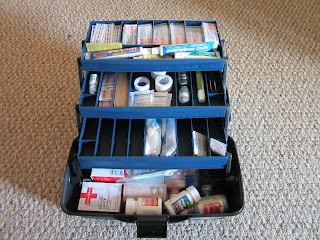Last year we were fortunate enough to only need band-aids and minor things with the girls. However, on the weekends we were not camping, it seemed that we had more accidents, including two trips to the E.R. since the big ones happened to occur on Sundays when the doctors office is closed. So, we pulled out the first aid bin and went thru the contents, made a shopping list, and then went to Wal-mart. Even though they didn't have everything we were looking for, it gave us a good start and saved us some money I'm sure.
 |
| Bella Didn't have RED duct tape, so we used Pink :-) |
Instead of a clamping lid storage container, we elected to purchase a cheap plastic fishing tackle box for this year and use that to organize our items. Mainly, right upon opening it we have the variety of band-aids and ointments that would more likely be all we would need for the minor things the girls often complain about.
If the accident requires further cleaning, repair, or splinting, then we open the tackle box and Presto! We have a mini doctors office at our disposal.
When I arrive to the campsite I also check the 30amp Shore power for proper polarity and voltage. I had been doing this test by holding open the lid of the panel and checking with my multi-meter. This can be a clumsy situation sometimes, especially if the power box has a lid that you have to hold up. Why is this important? Well, you want to be certain that you have the proper grounding for your hook up, as well as that your power is within the proper range to operate the equipment. In the middle of July and August the power grid at the campground can be taxed for voltage if everyone is running their AC or equipment. Having a low voltage condition can cause damage to the Air Conditioner operation, Microwaves, etc. See this LINK for additional information.
So, I found a 30amp Male to 15 amp Female adapter for only $8. I also found a combination Voltage tester and polarity Tester on Amazon. Now, with one plug assembly, I can read the voltage at the shore power post and check polarity. And, I can plug this into an outlet inside my camper to occasionally monitor the voltage.
The fishing tackle was also looked at and cleaned up, along with each of the kids rods and reels inspected. Our first camping trip has a Trout Derby on Saturday for the kids, so we are hoping to start off the season by catching some big ones! Now they can be taken over to the camper and stored in our slide out rod holder.
Now to get the batteries ready for the smoke detector, flash lights, and spares too!




Great suggestions Mr Schaffer, I am horrified to thing of how many campers are not checking the pedistal. Most are not aware of the danger involved in a Hot Skin senario from reversed polarity's on the outlet. I have not found one yet and hope I never do.
ReplyDeleteKevin in Lancaster Pa.
I am surprised too at those that show up and just plug in, without even turning off the breaker while they make their connection. I just didn't feel comfortable to keep using my multimeter to do the test in. While safe, this setup is now safer and easier.
DeleteTwo things to know about your test setup. First, that particular voltage tester will not survive being plugged into an outlet that's been accidentally mis-wired with 240-volts instead of 120-volts. How do I know this? I set up an experiment to try it and the tester did a little "bang" and the smoke rolled out of it. How does this happen? Well the 30-amp/120-volt RV outlet (TT-30 receptacle) looks very similar to the old 30-amp/240-volt dryer outlet. And old-school electricians (and DIY guys) sometimes make this mistake. See my No~Shock~Zone article at http://www.noshockzone.org/accidentally-plugging-into-240-volt-outlet/
ReplyDeleteSecondly, your test will not protect you against an outlet that's been mis-wired with something I call an RPBG (Reverse Polarity Bootleg Ground). An RPBG can happen when an old (pre-1970's) wiring system has been improperly upgraded to "grounded" outlets without running new wiring. A so called "Bootleg Ground" that's also "Reversed Polarity" will electrify the chassis of anything plugged into it that has a ground plug. This creates a so-called "hot-skin" with 120-volts on the body of your RV and truck. And everything will operate normally without any signs of trouble. In fact, there are no testers on the market that will tell you the outlet is RPBG, nor will any of the RV voltage surge/voltage suppressors detect or disconnect you from one. However, I've pioneered a basic RPBG test using a $20 Non Contact Voltage Tester (NCVT) which will show you if the outlet has a hot ground from an RPBG before plugging in. It will also show you if your RV's grounding system has failed internally which can create a hot-skin condition as well.
See my articles at http://www.rvdoctor.com/2001/07/friends-of-gary-mike.html and http://ecmweb.com/contractor/failures-outlet-testing-exposed or video at http://www.youtube.com/watch?v=Y8h64X33aKg for info on this RPBG condition. While an RPBG should NEVER occur at a modern campground, it's way too common on older garage and basement outlets that you may plug into when camping in a friend's driveway. So always measure the outlet voltage before plugging in. And NEVER accept feeling a shock from any appliance or RV. The next shock could kill you or someone you love.